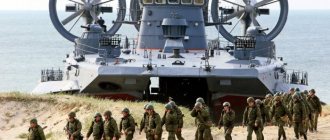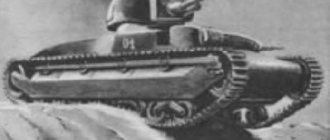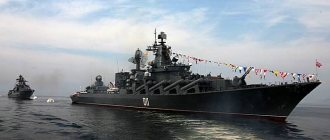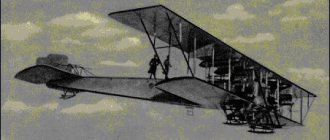The Polish authorities have recently intensified their policy towards militarization of the country. First of all, this is being done by attracting the American military - a significant part of the former German contingent of the US Army is moving to Polish territory. However, Warsaw also pays considerable attention to strengthening its own armed forces, one of the most technologically advanced types of which is the navy. However, there is an opinion that the Polish Ministry of Defense realized it too late - the Polish Navy has long been a collection of floating “museum exhibits”.
How the Polish fleet was born
When the war ended in 1918, Poland declared independence. Then the Polish naval forces were laid down. The signing of the Treaty at Versailles gave the country a 70 km wide corridor and two ports. One of the ports was Puck, where the Polish Navy began to be based. When Germany capitulated, a dozen ships came under the jurisdiction of Poland, including four minesweepers, six destroyers, and a pair of gunboats.
The first fleet development program in Poland was presented in 1920. It was designed for ten years and involved the construction of:
- Battleships – 2 units.
- Destroyers - 28 units.
- Cruisers - 6 units.
- Many small ships.
But such an ambitious program was not implemented, and four years later they developed a “small program,” which was more modest and consisted of a dozen submarines and destroyers, a couple of cruisers and six destroyers. This program also failed to be fully implemented; three units of minelayers were purchased. After some time, two destroyers were added to them.
We also worked on coastal infrastructure in Poland. As a result of such work, the first Polish naval aviation appeared in Puck in the same period of time. As a result of the Great Depression, they decided not to implement the small program.
1936 was marked by a new program, according to which they planned to rearm the Polish Navy, designed for six years. This program provided:
- 12 submarines;
- torpedo boats - 10;
- destroyers - 8;
- minesweepers - 12;
- minelayer.
Before the Second World War began, Poland had 5 submarines, 2 gunboats, 4 destroyers, one combat ship for laying minefields, 6 minesweepers.
A few months after the liberation of Poland from the Nazis, a decision was made to create a Navy with headquarters located in Gdynia. The Polish Navy was tasked with protecting sea borders and removing mines from adjacent sea areas. Poland's sea corridor was now 500 km.
A year later, the Polish Navy received 23 ships from the USSR.
Poland was a member of the Warsaw Pact until it joined NATO in 1991, 8 years after the collapse of the USSR.
Notes
- [www.mw.mil.pl/index.php?akcja=karweta Wiceadmirał Andrzej Karweta]
- Military-political cooperation of socialist countries. M., “Science”, 1988. p.122
- [www.mw.mil.pl/index.php?akcja=zwiazkitakt Struktura Organizacyjna Marynarki Wojennej]
- [www.mw.mil.pl/index.php?akcja=3flot 3 Flotylla Okrętów]
- [www.3fo.mw.mil.pl/index.php?akcja=dywizjon_rakietowy Dywizjon Okrętów Rakietowych]
- [www.mw.mil.pl/index.php?akcja=8flot 8 Flotylla Obrony Wybrzeża]
- [www.mw.mil.pl/index.php?akcja=bryglot Brygada Lotnictwa Marynarki Wojennej]
- ↑ 12
[www.mw.mil.pl/index.php?akcja=oliver Fregaty rakietowe – typ “Oliver Hazard Perry”] - [lenta.ru/news/2013/11/05/frigate/ The United States will modernize the Polish frigate]
- [www.mw.mil.pl/index.php?akcja=kaszub Korweta zwalczania okrętów podwodnych ORP “Kaszub”]
- ↑ 123
[www.mw.mil.pl/index.php?akcja=orkan Małe okręty rakietowe projektu 660] - [www.mw.mil.pl/index.php?akcja=stadm Stopnie oficerskie]
- [www.mw.mil.pl/index.php?akcja=stchor Stopnie podoficerskie]
- [www.mw.mil.pl/index.php?akcja=stpodof Stopnie marynarskie]
The current composition of the Polish fleet
In 2012, the modern Polish Navy, which includes ships, submarines, and patrol boats, according to some sources, numbered 41 combat units, including ships and boats. Auxiliary vessels and boats reached 15 units.
In addition to naval combat and other vessels, the Polish Navy is currently armed with coastal missile systems, naval aircraft and helicopters.
Ships ships flags
Warship flags
| Flag | Jack | Warship pennant |
Auxiliary vessel flags
Official flags
| President of the Polish Republic | Minister of National Defense | |
| Marshal of Poland | Chief of the General Staff of the Armed Forces | Commander-in-Chief of the Navy |
| Fleet Admiral | Admiral | Vice Admiral |
| Rear Admiral | General | Chief of staff |
| Flotilla Commander | Division commander | Group commander |
Submarines
According to the Polish Navy website and Wikipedia, they have five submarines:
- "Ozhel", project 877E. It entered service on April 29, 1986, and has been under repair since 2014.
- "Sokul" Project Cobben. It was put into operation on 06/04/2002.
- The Semp submarine of the Kobben project entered the Navy on August 16, 2002.
- “Belik” of the Kobben project, which became part of the Navy on 09/08/2003.
- The Condor submarine, Project Cobben, entered the fleet on 10/20/2004.
Norwegian diesel-electric submarines of the Kobben project were produced in the 1960s. Submarines were in service with this country until the 1990s. Several units were then transferred to Poland. This is the current composition of the Polish Navy.
Submarines of Project 877 or “Kilo” (according to NATO classification) have been produced in the Soviet Union since 1982. Since it was planned to equip the Warsaw Pact countries with these combat underwater vehicles, the project was called “Varshavyanka”. One submarine of this project is in service in Poland.
Detailed information about the history of warships and submarines can be found on the Polish Navy page on the balancer.
Swedish second hand
Wait, don’t take me out: Trump announced a reduction in the number of troops in Germany
The Pentagon refused to rush to implement the order of the commander in chief
At the end of July, the Polish press reported that protracted negotiations on Warsaw’s acquisition of two submarines from Sweden for its fleet had reached the final stage. Each of these submarines is armed with six bow 533 mm torpedo tubes, as well as three bow 400 mm torpedo tubes. Moreover, the Swedes themselves consider the Södermanland and Östergötland submarines to be outdated and worn out - and, objectively speaking, they are. They were built in 1985–90, that is, they are already 30 years old. True, in 2000–2005, both underwent deep modernization, during which both submarines received anaerobic engines capable of converting diesel fuel into electricity without requiring air.
However, Östergötland was taken out of service back in 2011 and has since been used as a spare parts donor for Södermanland. The latter was planned to be written off in 2022, since its further modernization was considered too costly. Therefore, the Polish offer for the Swedes turned out to be extremely profitable - to sell the lords two ships, which were already considered as scrap metal. The Scandinavians themselves intend to use the proceeds to purchase two much more modern submarines from Singapore.
Poland
Submarine Södermanland in Stockholm
Photo: commons.wikimedia.org
Horses for winged hussars: Poland is preparing the largest upgrade of its arsenal
The country's Ministry of Defense presented a new arms procurement program
The editor-in-chief of the Baltic military-historical magazine Baltfort, writer Yuri Melkonov, told Izvestia that the main drawback of the Polish fleet is its age.
“We constantly receive messages about ships celebrating 30- and 40-year anniversaries. There are no new ships, and the existing ones have all the problems that old ships have, notes Melkonov. Nevertheless, according to him, the Poles keep their ships “in tension and readiness” - they can always be seen while they are escorting Russian ships on the sea routes between St. Petersburg and Kaliningrad.
In January, the magazine Poland and the World published a review of the state of the country's Navy, clarifying that the situation with submarines is critical. “Our submarines are so old that no one in NATO considers them as weapons that can be used in an emergency,” the magazine quotes Rear Admiral Miroslav Mordel as saying why Polish submariners still sail on a submarine “Belik”, which turned 53 years old the day before. This is a former Norwegian Svenner substrate, scheduled for decommissioning this year.
Frigates
Not every country in Europe can boast of having frigates in service, but Poland has two of them:
- "General Kazimir Pulawski."
- Frigate "General Tadeusz Kosciuszko".
Frigates of the Oliver Hazard Perry project have been built since 1977 in the USA. Their main purpose is escort ships. A ship of this class has anti-submarine, anti-aircraft, artillery, anti-ship weapons, helicopters for anti-submarine defense and other tasks.
These are the combat vessels of the Polish Navy, photos and characteristics of which can be found on the official website of the department and some in our article.
Equipment and weapons
| This section of the article has not been written. According to the plan of one of the Wikipedia participants, a special section should be located in this place. You can help by writing this section. |
Corvette
The Polish Navy has one Project 620 patrol ship, the Kashub, which was delivered to the country's arsenal in 1987. The ship has weapons:
- Radar.
- Radioelectronic.
- Artillery (including anti-aircraft installations).
- Anti-submarine.
- Mine and torpedo.
The task of this warship is to protect the maritime borders of Poland.
An excerpt characterizing the Polish Naval Forces
“Hello, your Excellency,” he said to Anatoly as he entered and also extended his hand. “I’m telling you, Balaga,” said Anatole, putting his hands on his shoulders, “do you love me or not?” A? Now you've done your service... Which ones did you come to? A? “As the ambassador ordered, on your animals,” said Balaga. - Well, do you hear, Balaga! Kill all three and come at three o'clock. A? - How will you kill, what will we go on? - Balaga said, winking. - Well, I’ll break your face, don’t joke! – Anatole suddenly shouted, rolling his eyes. “Why joke,” the coachman said, chuckling. - Will I be sorry for my masters? As long as the horses can gallop, we will ride. - A! - said Anatole. - Well, sit down. - Well, sit down! - said Dolokhov. - I’ll wait, Fyodor Ivanovich. “Sit down, lie, drink,” said Anatole and poured him a large glass of Madeira. The coachman's eyes lit up at the wine. Refusing for the sake of decency, he drank and wiped himself with a red silk handkerchief that lay in his hat. - Well, when to go, Your Excellency? - Well... (Anatole looked at his watch) let’s go now. Look, Balaga. A? Will you be in time? - Yes, how about departure - will he be happy, otherwise why not be in time? - Balaga said. “They delivered it to Tver and arrived at seven o’clock.” You probably remember, Your Excellency. “You know, I went from Tver once for Christmas,” said Anatole with a smile of memory, turning to Makarin, who looked at Kuragin with all his eyes. – Do you believe, Makarka, that it was breathtaking how we flew. We drove into the convoy and jumped over two carts. A? - There were horses! - Balaga continued the story. “I then locked the young ones attached to the Kaurom,” he turned to Dolokhov, “so would you believe it, Fyodor Ivanovich, the animals flew 60 miles; I couldn’t hold it, my hands were numb, it was freezing. He threw down the reins, holding it, Your Excellency, himself, and fell into the sleigh. So it’s not like you can’t just drive it, you can’t keep it there. At three o'clock the devils reported. Only the left one died. Anatole left the room and a few minutes later returned in a fur coat belted with a silver belt and a sable hat, smartly placed on his side and suiting his handsome face very well. Looking in the mirror and in the same position that he took in front of the mirror, standing in front of Dolokhov, he took a glass of wine. “Well, Fedya, goodbye, thank you for everything, goodbye,” said Anatole. “Well, comrades, friends... he thought about... - my youth... goodbye,” he turned to Makarin and the others. Despite the fact that they were all traveling with him, Anatole apparently wanted to make something touching and solemn out of this address to his comrades. He spoke in a slow, loud voice and with his chest out, he swayed with one leg. - Everyone take glasses; and you, Balaga. Well, comrades, friends of my youth, we had a blast, we lived, we had a blast. A? Now, when will we meet? I'll go abroad. Long lived, goodbye guys. For health! Hurray!.. - he said, drank his glass and slammed it on the ground. “Be healthy,” said Balaga, also drinking his glass and wiping himself with a handkerchief. Makarin hugged Anatole with tears in his eyes. “Eh, prince, how sad I am to part with you,” he said. - Go, go! - Anatole shouted. Balaga was about to leave the room. “No, stop,” said Anatole. - Close the doors, I need to sit down. Like this. “They closed the doors and everyone sat down. - Well, now march, guys! - Anatole said standing up. The footman Joseph handed Anatoly a bag and a saber, and everyone went out into the hall. -Where is the fur coat? - said Dolokhov. - Hey, Ignatka! Go to Matryona Matveevna, ask for a fur coat, a sable cloak. “I heard how they were taking away,” Dolokhov said with a wink. - After all, she will jump out neither alive nor dead, in what she was sitting at home; you hesitate a little, there are tears, and dad, and mom, and now she’s cold and back - and you immediately take him into a fur coat and carry him into the sleigh. The footman brought a woman's fox cloak. - Fool, I told you sable. Hey, Matryoshka, sable! – he shouted so that his voice was heard far across the rooms. A beautiful, thin and pale gypsy woman, with shiny black eyes and black, curly, bluish-tinged hair, in a red shawl, ran out with a sable cloak on her arm. “Well, I’m not sorry, you take it,” she said, apparently timid in front of her master and regretting the cloak. Dolokhov, without answering her, took the fur coat, threw it on Matryosha and wrapped her up. “That’s it,” said Dolokhov. “And then like this,” he said, and lifted the collar near her head, leaving it only slightly open in front of her face. - Then like this, see? - and he moved Anatole’s head to the hole left by the collar, from which Matryosha’s brilliant smile could be seen. “Well, goodbye, Matryosha,” said Anatole, kissing her. - Eh, my revelry is over here! Bow to Steshka. Well, goodbye! Goodbye, Matryosha; wish me happiness. “Well, God grant you, prince, great happiness,” said Matryosha, with her gypsy accent. There were two troikas standing at the porch, two young coachmen were holding them. Balaga sat down on the front three, and, raising his elbows high, slowly took apart the reins. Anatol and Dolokhov sat down with him. Makarin, Khvostikov and the footman sat in the other three. - Are you ready, or what? – asked Balaga. - Let go! - he shouted, wrapping the reins around his hands, and the troika rushed down Nikitsky Boulevard. - Whoa! Come on, hey!... Whoa, - you could only hear the cry of Balaga and the young man sitting on the box. On Arbat Square, the troika hit a carriage, something crackled, a scream was heard, and the troika flew down Arbat. Having given two ends along Podnovinsky, Balaga began to hold back and, returning back, stopped the horses at the intersection of Staraya Konyushennaya. The good fellow jumped down to hold the horses' bridles, Anatol and Dolokhov walked along the sidewalk. Approaching the gate, Dolokhov whistled. The whistle responded to him and after that the maid ran out. “Go into the yard, otherwise it’s obvious he’ll come out now,” she said. Dolokhov remained at the gate. Anatole followed the maid into the yard, turned the corner and ran onto the porch. Gavrilo, Marya Dmitrievna’s huge traveling footman, met Anatoly. “Please see the lady,” the footman said in a deep voice, blocking the way from the door. - Which lady? Who are you? – Anatole asked in a breathless whisper. - Please, I've been ordered to bring him. - Kuragin! back,” Dolokhov shouted. - Treason! Back! Dolokhov, at the gate where he stopped, was struggling with the janitor, who was trying to lock the gate behind Anatoly as he entered. Dolokhov, with his last effort, pushed the janitor away and, grabbing the hand of Anatoly as he ran out, pulled him out the gate and ran with him back to the troika. Marya Dmitrievna, finding a tearful Sonya in the corridor, forced her to confess everything. Having intercepted Natasha’s note and read it, Marya Dmitrievna, with the note in her hand, went up to Natasha. “Bastard, shameless,” she told her. - I don’t want to hear anything! - Pushing away Natasha, who was looking at her with surprised but dry eyes, she locked it and ordered the janitor to let through the gate those people who would come that evening, but not to let them out, and ordered the footman to bring these people to her, sat down in the living room, waiting kidnappers. When Gavrilo came to report to Marya Dmitrievna that the people who had come had run away, she stood up with a frown and folded her hands back, walked around the rooms for a long time, thinking about what she should do. At 12 o'clock at night, feeling the key in her pocket, she went to Natasha's room. Sonya sat in the corridor, sobbing. - Marya Dmitrievna, let me see her for God’s sake! - she said. Marya Dmitrievna, without answering her, unlocked the door and entered. “Disgusting, nasty... In my house... Vile little girl... I just feel sorry for my father!” thought Marya Dmitrievna, trying to quench her anger. “No matter how difficult it is, I’ll tell everyone to be silent and hide it from the count.” Marya Dmitrievna entered the room with decisive steps. Natasha lay on the sofa, covering her head with her hands, and did not move. She lay in the same position in which Marya Dmitrievna had left her. - Good, very good! - said Marya Dmitrievna. - In my house, lovers can make dates! There's no point in pretending. You listen when I talk to you. – Marya Dmitrievna touched her hand. - You listen when I talk. You have disgraced yourself like a very lowly girl. I would do that to you, but I feel sorry for your father. I'll hide it. – Natasha did not change her position, but only her whole body began to jump up from silent, convulsive sobs that choked her. Marya Dmitrievna looked back at Sonya and sat down on the sofa next to Natasha. - He’s lucky that he left me; “Yes, I will find him,” she said in her rough voice; – Do you hear what I’m saying? “She put her big hand under Natasha’s face and turned her towards her. Both Marya Dmitrievna and Sonya were surprised to see Natasha’s face. Her eyes were shiny and dry, her lips were pursed, her cheeks were drooping. “Leave... those... that I... I... will die...” she said, with an angry effort she tore herself away from Marya Dmitrievna and lay down in her previous position. “Natalya!...” said Marya Dmitrievna. - I wish you well. You lie down, just lie there, I won’t touch you, and listen... I won’t tell you how guilty you are. You know it yourself. Well, now your father is coming tomorrow, what will I tell him? A? Again Natasha's body shook with sobs. - Well, he will find out, well, your brother, groom! “I don’t have a fiance, I refused,” Natasha shouted. “It doesn’t matter,” continued Marya Dmitrievna. - Well, they’ll find out, so why leave it like that? After all, he, your father, I know him, after all, if he challenges him to a duel, will it be good? A? - Oh, leave me alone, why did you interfere with everything! For what? For what? who asked you? - Natasha shouted, sitting up on the sofa and looking angrily at Marya Dmitrievna. - What did you want? - Marya Dmitrievna cried out again, getting excited, - why did they lock you up? Well, who stopped him from going to the house? Why should they take you away like some kind of gypsy?... Well, if he had taken you away, what do you think, he wouldn’t have been found? Your father, or brother, or fiancé. And he’s a scoundrel, a scoundrel, that’s what! “He’s better than all of you,” Natasha cried, standing up. - If you hadn’t interfered... Oh, my God, what is this, what is this! Sonya, why? Go away!... - And she began to sob with such despair with which people only mourn such grief, which they feel themselves to be the cause of. Marya Dmitrievna began to speak again; but Natasha shouted: “Go away, go away, you all hate me, you despise me.” – And again she threw herself on the sofa. Marya Dmitrievna continued for some time to admonish Natasha and convince her that all this must be hidden from the count, that no one would find out anything if only Natasha took it upon herself to forget everything and not show to anyone that anything had happened. Natasha didn't answer. She didn’t cry anymore, but she began to feel chills and trembling. Marya Dmitrievna put a pillow on her, covered her with two blankets and brought her some lime blossom herself, but Natasha did not respond to her. “Well, let him sleep,” said Marya Dmitrievna, leaving the room, thinking that she was sleeping. But Natasha was not sleeping and, with fixed, open eyes, looked straight ahead from her pale face. All that night Natasha did not sleep, and did not cry, and did not speak to Sonya, who got up and approached her several times.
Problems of the modern Polish fleet
Despite their formidable numbers, warships, submarines, airplanes, helicopters and other weapons need modernization. Some weapons have undergone this modernization, for example, Project 660 missile boats and coastal anti-ship systems. But this is clearly not enough to carry out combat missions in modern naval theaters of war.
And the modernized technology went through a thorny path before it became more or less modern. What are the reasons for the lack of modern equipment in the Polish fleet? This:
- Lack of funding. Poland is a member of NATO, but the country does not receive sufficient quantities of new weapons from its older brothers in the alliance. Those warships that are in service need modern improvements.
- Poland itself does not have the production, scientific and technical capabilities to develop its own warships. Otherwise, they would have been built or in service a long time ago. Poland is forced to turn to technologically advanced powers for the purchase of such ships.
- The economic crisis also slowed down the development of Poland's weapons.
- The restrictions that NATO membership imposes on a country. Poland can only turn to alliance member countries for weapons. It is unlikely to decide to purchase weapons from other countries.
Time does not stand still. Old weapons will have to be written off over time; they do not last forever. The Polish Navy needs to look for a way to modernize its weapons and equipment. Without solving this problem, the amount of military equipment in the fleet will gradually decline.
Insignia
Admirals and officers
| Categories | Admirals[12] | Senior officers | Junior officers | |||||||
| Polish rank | Admiral | Admiral fleet | Wiceadmirał | Kontradmirał | Komandor | Komandor porucznik | Komandor podporucznik | Kapitan marynarki | Porucznik marynarki | Podporucznik marynarki |
| Russian compliance | Fleet Admiral | Admiral | Vice Admiral | Rear Admiral | Captain 1st rank | Captain 2nd rank | Captain 3rd rank | Lieutenant Commander | Senior Lieutenant | Lieutenant |
Sub-officers and sailors
| Categories | Sub-officers[13] | Sailors[14] | ||||||||||
| Polish rank | Starszy chorąży sztabowy | Chorąży sztabowy | Młodszy chorąży sztabowy | Starszy chorąży | Chorąży | Młodszy chorąży | Starszy bosman | Bosman | Bosmanmat | Mat | Starszy marynarz | Marynarz |
| Russian compliance | No | No | No | Senior midshipman | Midshipman | No | Chief petty officer | Chief Petty Officer | Petty Officer of the first article | Foreman of the second article | Senior sailor | Sailor |
Badges on hats
- Orzelmarynarkawojenna.svg
Record unfinished construction
In total, the Polish Navy consists of more than forty ships. The newest - or rather, conditionally new ship of the Polish fleet is the patrol corvette Ślązak (Silesian), tail number 241, the flag on which was raised on November 28, 2022. The history of this ship resulted in a scandalous long-term construction that lasted 18 years. Ślązak was originally laid down as part of the Gawron II program, under which Warsaw intended to allocate money for seven multi-purpose corvettes intended to form the core of the Polish surface fleet by 2012. The project was developed in collaboration between Polish and German shipbuilders; the lead ship Ślązak was laid down in Gdynia on November 28, 2001 and was planned for commissioning in 2003. But due to chronic underfunding, the program was first reduced to three, later to two ships, and then canceled altogether. True, Ślązak, which had already begun to be built, was launched on September 16, 2009, and abandoned.
The Stocznia Marynarki Wojennej shipyard that carried out the work went bankrupt in 2011, and in February 2012 the Polish government decided to sell the unfinished Ślązak for metal. But the leadership of the Polish Navy and representatives of the Polish shipbuilding industry put pressure on the government - and in 2013 they decided to complete the long-suffering Ślązak, but according to a significantly simplified project with reduced armament. We intended to deliver the corvette to the fleet by the end of 2016, but were two years late. The ship first entered sea trials in 2018, and only on November 8, 2019, the acceptance certificate was signed. At the same time, the Silesian, which was built for so long and with such efforts, is by no means a super-dreadnought: a displacement of 1900 tons, a length of 95.2 m, armament in the form of a 76-mm universal artillery mount, two 30-mm and four 12.7-mm machine guns , four Grom anti-aircraft missile launchers.
Poland
Patrol corvette Ślązak
Photo: Global Look Press
Prior to this, in 2022, the first Polish-made ship in 20 years to be introduced into the country’s fleet was the Kormoran minesweeper. Warsaw also has at its disposal two old frigates “Kazimir Pulawski” and “Tadeusz Kosciuszko” (American type “Oliver H. Perry”, built back in the 70s), a 33-year-old patrol ship “Kashub”, three missile boats “Orkan” , “Perun” and “Grom” (armed with RBS15 Mk3 anti-ship missiles with a range of more than 200 km), also already quite old, and three ancient submarines. Of these, two former Norwegian submarines of the Kobben type, built back in the 60s, should be disposed of this year, 2022. There is only one submarine left, the Orel (the former Soviet Project 877E Halibut submarine, in service since 1986), but if it is not urgently modernized, it will also have to be decommissioned in two years. In 2022, by the way, there was a big fire on this submarine.
“There is no second such old operational fleet in all of NATO. This is an open air museum. Nobody in NATO views the Polish fleet as a weapon that can be used in an emergency,” emphasizes Mariusz Silma, editor-in-chief of the Polish magazine New Military Technologies. According to Melkonov, “American frigates did not bring anything good to the Polish fleet - and in general it is surprising that Poland, which has an excellent shipbuilding industry, is trying to purchase almost all warships abroad.” According to the expert, this may be explained by disagreements between the country's top leadership, the Ministry of Defense, the generals and the command of the Polish fleet.
The Polish fleet also includes landing ships and boats, minesweepers, and support vessels. One of these landing ships, the 1,754-ton Gniezno built in 1990, got into trouble last year, 2019. Participating in the international NATO exercise Baltops-2019, the ship was supposed to land troops on the Lithuanian coast of the Baltic, but broke through its bottom. A hole formed in the hull, into which water poured. There was considerable confusion. A video of a damaged ship off the coast was posted on YouTube, and regulars on Polish social networks began to ridicule the incident. “Donkeys, they destroyed the last ship of Poland!” “The only Polish warship sank... Without a fight,” “They probably did this on purpose to justify the purchase of several new aircraft carriers from the United States,” “When I drink, I don’t swim,” the Poles wrote sarcastically. Some noted that the Polish ship got off easy, and recalled the disaster of the Norwegian frigate Helge Ingstad, which collided with a tanker in November 2018 and sank off its native shores.
Links[edit]
- "Archival copy". Archived from the original on 2010-10-11. Retrieved 12 January 2011.CS1 maint: archived copy as title (link)
- ^ abcdefg Juliusz Bardach, Boguslaw Lesnodorski and Michal Pietrzak, Historia panstwa i prawa polskiego
(Warsaw: Paristwowe Wydawnictwo Naukowe), 1987, p. 231 - ↑
Michael Roberts (27 April 1984). The Swedish Imperial Experience 1560–1718. Cambridge University Press. pp. 16–17. ISBN 978-0-521-27889-8. Archived from the original on May 30, 2016. Retrieved June 7, 2011. - Jerzy Pertek Polacy on morzach I oceanach: Do Roku 1795
, page 176 - ^ ab "Rozczarowujące BME 2010". Altair. Archived from the original on 2012-03-13. Retrieved April 17, 2012.
- ^ ab New harmonogram modernizacji MW RP. Archived February 2, 2022, at the Wayback Machine Altair, January 20, 2022 (in Polish).
- Concept for the development of the Polish fleet. Archived on March 5, 2017 at the Wayback Machine amberexpo.pl.
- Miecznik i Czapla częściowo odtajnione. Archived July 15, 2013, at the Wayback Machine Altair (in Polish).
- TECHNICAL PLAN FOR MODERNIZATION OF THE ARMED FORCES for 2013–2022. Archived January 18, 2013 at the Wayback Machine (in Polish).
- "Polish Navy to acquire new submarine". Defense News
. Retrieved December 14, 2014. - "Gawron na wodzie" . Altair. Archived from the original on 2012-03-13. Retrieved April 17, 2012.
- "ORP Pułaski - pływający złom". Altair. Archived from the original on 2012-03-13. Retrieved April 17, 2012.
- “Rakiety dla samolotów, okrętów i wyrzutni naziemnych. Polska army ostrzy kły". TVN24.pl
. Archived from the original on December 3, 2014. Retrieved December 14, 2014. - "RBS15 Mk 3 Surface-to-Surface Missile SSM in use". Saab Group. Archived from the original on October 24, 2010.
- "defence.professionals" . defpro.com. Archived from the original on 2012-06-30. Retrieved April 17, 2012.
- "Poland evaluates three bids for helicopter". Archived from the original on April 9, 2022. Retrieved April 8, 2022.
- ↑
Minister of Defense: We need to expand the Polish fleet. Archived October 4, 2022, at the Wayback Machine on 07/02/2015. - "Staffing the NDR". Altair. Archived from the original on July 3, 2015.
- "Polish Navy". Archived from the original on December 18, 2014. Retrieved December 14, 2014.
- "Marinarka Voyenna". www.jednostki-wojskowe.pl
. Archived from the original on September 26, 2022. Retrieved September 26, 2018. - Rydzyk | 2012 | www.rczpi.wp.mil.pl, made by RCZPI | design by Patryk. ".. :: :: Ednostki ::." blmw.wp.mil.pl
(in Polish). Archived from the original on September 26, 2022. Retrieved September 26, 2022. - ^ ab "Wyposażenie". Wojsko-Polskie.pl
(in Polish). Retrieved December 11, 2022. - "Miglowiec transportowy Mi-2". Wojsko-Polskie.pl
(in Polish). Retrieved December 11, 2022. - ↑
Perry, Donald (April 26, 2022).
"Poland orders four AW101 helicopters for Navy". Flightglobal
. Retrieved April 26, 2022. - "Śmigłowiec poszukiwawczo - ratowniczy W-3WARM Anakonda". Wojsko-Polskie.pl
(in Polish). Retrieved December 8, 2022.
Origin
The Polish Navy has its roots in warships, which were mainly used on the main rivers of Poland in defense of commerce and trade. During the Thirteen Years' War (1454–66), this small force of inland ships saw real high seas fighting for the first time. At the Battle of the Vistula Lagoon, the Polish privateer fleet defeated the Teutonic navy and secured permanent access to the Baltic Sea. Second World of Thorn (1466) acquired for Poland the strategic naval city of Danzig (Gdańsk), and with it the means of maintaining a large fleet in the Baltic. In 1561, after defeating the Russian Naval forces in the Baltic, the Polish Navy acquired a second key port at Riga in modern Latvia.
At a time when Poland and Lithuania became involved in conflicts in Livonia, the Polish king Zygmunt August organized the Maritime Commission (Komisja Morska).
, operating in the years 1568–1572, and supported privateer operations, but this met with the opposition of Poland's main port, Gdańsk (Danzig), which saw them as a threat to its trading activities (see Baltic grain trade). This led to the development of a privateer port at Shaibe.
Around the beginning of the 17th century Poland became controlled by the House of Vessels and was involved in a series of wars with Sweden (see also dominium mares baltici). The Vessel kings attempted to create a proper navy, but their attempts met with repeated failures, due to lack of funds in the royal treasury (the Polish nobility saw little need for a navy and refused to raise taxes for its construction, and Gdańsk continued its opposition to the idea of a royal navy). During the reign of Zygmunt III Vaca, the Commonwealth's most famous naval victory took place at the Battle of Oliwa in 1627 against Sweden, during the Polish-Swedish War. The victory over Sweden provided Poland with permanent access to the Atlantic and marked the beginning of expeditions outside Europe. Plans for an independent navy failed soon after due to the badly executed alliance with the Habsburgs, who in 1629 took over the fleet.
(Komisja Okrętów Królewskich) was created.
. This commission, along with the final distribution of funds by the Diet in 1637, created a permanent Commonwealth navy. Władysław IV Waza, who took the throne in 1632, bought 12 ships and built a special port for the royal fleet (Władysławowo). The fleet was destroyed in 1637 by Denmark without declaring war. Support for this navy was weak, and it largely died out by the 1640s; the remaining ships were sold in the years 1641–1643, which marked the end of the Commonwealth navy. A small privateer navy was also created by Augustus II the Strong in 1700 during the Great Northern War
The Duchy of Courland, by this time a fief of the Polish-Lithuanian Commonwealth, had a strong navy: it established colonies on the island of Tobago in the West Indies (called New Courland) and on the mouth of the Gambia River.
The Polish-Lithuanian Commonwealth, although the dominant power in Central and Eastern Europe during the 16th to 18th centuries, never developed its navy to full potential. Poland's proportionately small coastline and limited access to the Atlantic never allowed for a major naval buildup, especially not to the level of colonial powers such as England and France. The partition of Poland at the end of the 18th century brought an end to the independent Polish navy.
Warsaw Pact[edit]
Destroyers[edit]
- Kotlin-class destroyer ORP Warsaw (56)
- ORP Warsaw (271)
- ORP Grom (273)
Corvettes [edit]
- Corvette Tarantula I-class ORP Górnik (434)
- ORP Khutnik (435)
- ORP Metalowiec (436)
- ORP Rolnik (437)
Submarines [edit]
- Foxtrot-class submarine ORP Wilk (292)
- ORP Dzik (293)
- ORP Orzel (292)
- ORP Kaszub
Craft Missile Quick Attack[edit]
- Osa-class missile boat ORP Hel
(421) - ORP Gdansk
(422) - ORP Gdynia
(423) - ORP Kolobrzeg
(424) - ORP Szczecin
(425) - ORP Elblag
(426) - ORP washer
(427) - ORP Ustka
(428) - ORP Oksywie
(429) - ORP Darlowo
(430) - ORP Swinoujscie (431)
- ORP Dziwnow
(432) - ORP Vladyslawovo (433)
Torpedo boats[edit]
- Torpedo boat project 663D ORP Błyskawiczny
- ORP Bitny
(KTD-452)
(KTD-453)
(KTD-454)
(KTD-455)
(KTD-456)
(KTD-457)
(KTD-458)
(KTD-459)
Training ships[edit]
- Hansa type A ORP Zetempowiec, later renamed Gryf
Personnel decides everything
There is also an opinion that the Swedes were the real sea wolves of the Baltic. This judgment was largely generated by Russian and Soviet historiography in relation to the Great Northern War.
In reality, the Swedes were not renowned sailors either under Charles XII or under Gustav Adolf, and their most striking victories invariably won on land. Their neighbors and eternal opponents, the Danes, even gave them a very biting nickname - “swineherds who only learned about the sea by the whim of fate.”
Evgeny Bashin-Razumovsky Expert on historical issues
In Sweden, army service was considered more prestigious, and it also included higher salaries.
Admiral Sternhold also cannot be called an experienced sailor. He was a land officer who had made a good military career, in the recent past he was the governor of Dorpat, but, alas, not a sailor. This is a completely typical situation of those times for the Swedish fleet, where high appointments were given for loyalty, nobility and other merits to people who sometimes had a very conditional relationship to the sea.
The Poles acted smarter in this regard. Nominally, the naval forces of the Polish-Lithuanian Commonwealth were commanded by Admiral Wilhelm Appelmann, but at the time of the events described he could not perform his duties due to serious illness, so the royal commissioners appointed Admiral Arend Diekmann, who was to be assisted as advisers by the commander of the marine corps Jan Storch and the chief artilleryman Hermann Witte .
Portrait of Arend Diekmann on the anniversary medal dedicated to the battle (photo source)
None of them were either Pole or Lithuanian. As for Appelmann and Dieckmann, it is known for certain that they were Dutch; Storch and Witte, apparently, too. True, Appelmann also served a significant part of his life as a land officer, but Diekmann was an experienced sailor and shipowner. Thus, the Polish authorities relied on hired officers from Holland, a recognized “maritime” power of that time.
Evgeny Bashin-Razumovsky Expert on historical issues
The ship crews of the Polish fleet could be called the “Northern European team” - it was easy to meet Danes, Dutch, Germans and even Scots there. Gustav Adolf also resorted to the services of mercenaries, but at the same time took various measures aimed at forming national teams. It turned out, however, with varying degrees of success.
Reaching Trump
Poland has historically had no luck with its fleet. The kings of the Polish-Lithuanian Commonwealth repeatedly tried to acquire strong naval forces, but in the end these naval forces achieved success only as an exception. One of them is described by historian Alexander Polubyako:
Until the end of the 18th century, which, as we know, put a limit to the existence of independent Poland, the fleet of this country was repeatedly recreated - and disappeared again: the ships sank, were sold, and were laid up. The truly Polish fleet was born only in the twentieth century, when the country regained its sovereignty. The Poles received a number of former German ships as a result of the First and Second World Wars, they got some from the British, and a lot from the USSR. But Warsaw's current naval concept is naturally based on the country's foreign policy and political orientation.
In many ways, last year's NATO summit in Warsaw is indicative. “The minimum task for PiS was to achieve an increase in the number of alliance soldiers on its territory. We have completed the task, we must move on - ask Washington for even more troops, and complete the construction of the US missile defense base. Just the other day, the Pentagon confirmed its intentions to deploy the Aegis Ashore multi-purpose anti-aircraft missile system in Redzikowo by 2022,” he recalled.
“The unacceptability of the concept of “two-speed Europe” for PiS and the weakening of the pro-American bloc in the EU after Brexit force Polish diplomacy to seek more support from overseas. Warsaw advertises itself to Washington as an Eastern European military frontier to counter the “Russian threat.” As part of this strategy, Warsaw is torpedoing the founding NATO-Russia Act of 1997, under which the alliance pledged not to station significant combat forces along Russia's borders on a permanent basis. At the same time, the Polish army is being modernized and submarines are being purchased. Thus, the leadership of the republic sends a signal to the new White House administration about the seriousness of its intentions. “We’re not just asking for something, but we’re investing in our own safety.” After all, it is known how intolerant Donald Trump is towards the low spending of NATO allies,” Starikov concluded.











